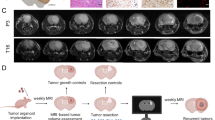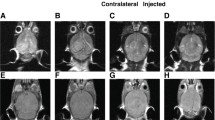Abstract
Glioblastoma multiforme (GBM) is a rapidly progressive disease of morbidity and mortality and is the most common form of primary brain cancer in adults. Lack of appropriate in vivo models has been a major roadblock to developing effective therapies for GBM. A new highly invasive in vivo GBM model is described that was derived from a spontaneous brain tumor (VM-M3) in the VM mouse strain. Highly invasive tumor cells could be identified histologically on the hemisphere contralateral to the hemisphere implanted with tumor cells or tissue. Tumor cells were highly expressive for the chemokine receptor CXCR4 and the proliferation marker Ki-67 and could be identified invading through the pia mater, the vascular system, the ventricular system, around neurons, and over white matter tracts including the corpus callosum. In addition, the brain tumor cells were labeled with the firefly luciferase gene, allowing for non-invasive detection and quantitation through bioluminescent imaging. The VM-M3 tumor has a short incubation time with mortality occurring in 100% of the animals within approximately 15 days. The VM-M3 brain tumor model therefore can be used in a pre-clinical setting for the rapid evaluation of novel anti-invasive therapies.









Similar content being viewed by others
Abbreviations
- CT-2A:
-
Mouse astrocytoma
- CXCR4:
-
Chemokine receptor
- GBM:
-
Glioblastoma multiforme
- IGFBP-2:
-
Insulin-like growth factor binding protein 2
- Ki-67:
-
Proliferation marker
- VM-M3:
-
Invasive mouse malignant glioma
- VM-M3/Fluc:
-
VM-M3 tumor cells labeled with firefly luciferase
- VM-NM1:
-
Mouse malignant glioma
References
Wen PY, Kesari S (2008) Malignant gliomas in adults. N Engl J Med 359:492–507
Chang SM, Parney IF, Huang W, Anderson FA Jr, Asher AL, Bernstein M, Lillehei KO, Brem H, Berger MS, Laws ER (2005) Patterns of care for adults with newly diagnosed malignant glioma. JAMA 293:557–564
Laws ER Jr, Goldberg WJ, Bernstein JJ (1993) Migration of human malignant astrocytoma cells in the mammalian brain: Scherer revisited. Int J Dev Neurosci 11:691–697
Rubinstein LJ (1972) Tumors of the central nervous system. Armed Forces Institute of Pathology, Washington, DC
Scherer HJ (1940) The forms of growth in gliomas and their practical significance. Brain 63:1–34
Duffner PK (2006) The long term effects of chemotherapy on the central nervous system. J Biol 5:21
Szatmari T, Lumniczky K, Desaknai S, Trajcevski S, Hidvegi EJ, Hamada H, Safrany G (2006) Detailed characterization of the mouse glioma 261 tumor model for experimental glioblastoma therapy. Cancer Sci 97:546–553
Huse JT, Holland EC (2009) Genetically engineered mouse models of brain cancer and the promise of preclinical testing. Brain Pathol (Zurich, Switzerland) 19:132–143
Candolfi M, Curtin JF, Nichols WS, Muhammad AG, King GD, Pluhar GE, McNiel EA, Ohlfest JR, Freese AB, Moore PF, Lerner J, Lowenstein PR, Castro MG (2007) Intracranial glioblastoma models in preclinical neuro-oncology: neuropathological characterization and tumor progression. J Neurooncol 85:133–148
Xie Q, Thompson R, Hardy K, DeCamp L, Berghuis B, Sigler R, Knudsen B, Cottingham S, Zhao P, Dykema K, Cao B, Resau J, Hay R, Vande Woude GF (2008) A highly invasive human glioblastoma pre-clinical model for testing therapeutics. J Transl Med 6:77
Fomchenko EI, Holland EC (2006) Mouse models of brain tumors and their applications in preclinical trials. Clin Cancer Res 12:5288–5297
Martinez-Murillo R, Martinez A (2007) Standardization of an orthotopic mouse brain tumor model following transplantation of CT-2A astrocytoma cells. Histol Histopathol 22:1309–1326
Maes W, Deroose C, Reumers V, Krylyshkina O, Gijsbers R, Baekelandt V, Ceuppens J, Debyser Z, Van Gool SW (2008) In vivo bioluminescence imaging in an experimental mouse model for dendritic cell based immunotherapy against malignant glioma. J Neurooncol 91(2):127-139
Mukherjee P, El-Abbadi MM, Kasperzyk JL, Ranes MK, Seyfried TN (2002) Dietary restriction reduces angiogenesis and growth in an orthotopic mouse brain tumour model. Br J Cancer 86:1615–1621
Mukherjee P, Abate LE, Seyfried TN (2004) Antiangiogenic and proapoptotic effects of dietary restriction on experimental mouse and human brain tumors. Clin Cancer Res 10:5622–5629
Barth RF (1998) Rat brain tumor models in experimental neuro-oncology: the 9L, C6, T9, F98, RG2 (D74), RT-2 and CNS-1 gliomas. J Neurooncol 36:91–102
Vince GH, Bendszus M, Schweitzer T, Goldbrunner RH, Hildebrandt S, Tilgner J, Klein R, Solymosi L, Christian Tonn J, Roosen K (2004) Spontaneous regression of experimental gliomas—an immunohistochemical and MRI study of the C6 glioma spheroid implantation model. Exp Neurol 190:478–485
Kruse CA, Molleston MC, Parks EP, Schiltz PM, Kleinschmidt-DeMasters BK, Hickey WF (1994) A rat glioma model, CNS-1, with invasive characteristics similar to those of human gliomas: a comparison to 9L gliosarcoma. J Neurooncol 22:191–200
Zagzag D, Esencay M, Mendez O, Yee H, Smirnova I, Huang Y, Chiriboga L, Lukyanov E, Liu M, Newcomb EW (2008) Hypoxia- and vascular endothelial growth factor-induced stromal cell-derived factor-1alpha/CXCR4 expression in glioblastomas: one plausible explanation of Scherer’s structures. Am J Pathol 173:545–560
Holland EC (2001) Gliomagenesis: genetic alterations and mouse models. Nat Rev Genet 2:120–129
Hu X, Holland EC (2005) Applications of mouse glioma models in preclinical trials. Mutat Res 576:54–65
Dai C, Holland EC (2001) Glioma models. Biochim Biophys Acta 1551:M19–M27
Louis DN (2006) Molecular pathology of malignant gliomas. Annu Rev Pathol 1:97–117
Parsons DW, Jones S, Zhang X, Lin JC, Leary RJ, Angenendt P, Mankoo P, Carter H, Siu IM, Gallia GL, Olivi A, McLendon R, Rasheed BA, Keir S, Nikolskaya T, Nikolsky Y, Busam DA, Tekleab H, Diaz LA Jr, Hartigan J, Smith DR, Strausberg RL, Marie SK, Shinjo SM, Yan H, Riggins GJ, Bigner DD, Karchin R, Papadopoulos N, Parmigiani G, Vogelstein B, Velculescu VE, Kinzler KW (2008) An integrated genomic analysis of human glioblastoma multiforme. Science (New York, NY) 321:1807–1812
Assanah M, Lochhead R, Ogden A, Bruce J, Goldman J, Canoll P (2006) Glial progenitors in adult white matter are driven to form malignant gliomas by platelet-derived growth factor-expressing retroviruses. J Neurosci 26:6781–6790
Heidner GL, Kornegay JN, Page RL, Dodge RK, Thrall DE (1991) Analysis of survival in a retrospective study of 86 dogs with brain tumors. J Vet Intern Med 5:219–226
LeCouteur RA (1999) Current concepts in the diagnosis and treatment of brain tumours in dogs and cats. J Small Anim Pract 40:411–416
Lipsitz D, Higgins RJ, Kortz GD, Dickinson PJ, Bollen AW, Naydan DK, LeCouteur RA (2003) Glioblastoma multiforme: clinical findings, magnetic resonance imaging, and pathology in five dogs. Vet Pathol 40:659–669
Foster ES, Carrillo JM, Patnaik AK (1988) Clinical signs of tumors affecting the rostral cerebrum in 43 dogs. J Vet Intern Med 2:71–74
Fraser H (1971) Astrocytomas in an inbred mouse strain. J Pathol 103:266–270
Fraser H (1986) Brain tumours in mice, with particular reference to astrocytoma. Food Chem Toxicol 24:105–111
Morantz RA, Wood GW, Foster M, Clark M, Gollahon K (1979) Macrophages in experimental and human brain tumors. Part 2: studies of the macrophage content of human brain tumors. J Neurosurg 50:305–311
Huysentruyt LC, Mukherjee P, Banerjee D, Shelton LM, Seyfried TN (2008) Metastatic cancer cells with macrophage properties: evidence from a new murine tumor model. Int J Cancer 123:73–84
Rossi ML, Jones NR, Candy E, Nicoll JA, Compton JS, Hughes JT, Esiri MM, Moss TH, Cruz-Sanchez FF, Coakham HB (1989) The mononuclear cell infiltrate compared with survival in high-grade astrocytomas. Acta Neuropathol Berl 78:189–193
Roggendorf W, Strupp S, Paulus W (1996) Distribution and characterization of microglia/macrophages in human brain tumors. Acta Neuropathol 92:288–293
Stevenson CB, Ehtesham M, McMillan KM, Valadez JG, Edgeworth ML, Price RR, Abel TW, Mapara KY, Thompson RC (2008) CXCR4 expression is elevated in glioblastoma multiforme and correlates with an increase in intensity and extent of peritumoral T2-weighted magnetic resonance imaging signal abnormalities. Neurosurgery 63:560–569 (discussion 569–570, 2008)
Bian XW, Yang SX, Chen JH, Ping YF, Zhou XD, Wang QL, Jiang XF, Gong W, Xiao HL, Du LL, Chen ZQ, Zhao W, Shi JQ, Wang JM (2007) Preferential expression of chemokine receptor CXCR4 by highly malignant human gliomas and its association with poor patient survival. Neurosurgery 61:570–578 (discussion 578–579, 2007)
Ehtesham M, Stevenson CB, Thompson RC (2008) Preferential expression of chemokine receptor CXCR4 by highly malignant human gliomas and its association with poor patient survival. Neurosurgery 63:E820 (author reply E820)
El-Abbadi M, Seyfried TN, Yates AJ, Orosz C, Lee MC (2001) Ganglioside composition and histology of a spontaneous metastatic brain tumour in the VM mouse. Br J Cancer 85:285–292
Huysentruyt LC, Shelton LM, Seyfried TN (2010) Influence of methotrexate and cisplatin on tumor progression and survival in the VM mouse model of systemic metastatic cancer. Int J Cancer 126(1):65–72
Ng WH, Yeo TT, Kaye AH (2005) Spinal and extracranial metastatic dissemination of malignant glioma. J Clin Neurosci 12:379–382
Hoffman HJ, Duffner PK (1985) Extraneural metastases of central nervous system tumors. Cancer 56:1778–1782
Kauffman HM, Cherikh WS, McBride MA, Cheng Y, Hanto DW (2007) Deceased donors with a past history of malignancy: an organ procurement and transplantation network/united network for organ sharing update. Transplantation 84:272–274
Lopes MBS, Vanbenberg SR, Scheithauer BW (1993) The world health organization classification of nervous system tumors in experimental neuro-oncology. In: Schmidek HH, Levine AJ (eds) Molecular genetics of nervous system tumors. Wiley, New York, pp 1–36
Liwnicz BH, Rubinstein LJ (1979) The pathways of extraneural spread in metastasizing gliomas: a report of three cases and critical review of the literature. Hum Pathol 10:453–467
Deroose CM, Reumers V, Gijsbers R, Bormans G, Debyser Z, Mortelmans L, Baekelandt V (2006) Noninvasive monitoring of long-term lentiviral vector-mediated gene expression in rodent brain with bioluminescence imaging. Mol Ther 14:423–431
Szentirmai O, Baker CH, Lin N, Szucs S, Takahashi M, Kiryu S, Kung AL, Mulligan RC, Carter BS (2006) Noninvasive bioluminescence imaging of luciferase expressing intracranial U87 xenografts: correlation with magnetic resonance imaging determined tumor volume and longitudinal use in assessing tumor growth and antiangiogenic treatment effect. Neurosurgery 58:365–372 (discussion 365–372, 2006)
Ranes MK, El-Abbadi M, Manfredi MG, Mukherjee P, Platt FM, Seyfried TN (2001) N-butyldeoxynojirimycin reduces growth and ganglioside content of experimental mouse brain tumours. Br J Cancer 84:1107–1114
Seyfried TN, el-Abbadi M, Roy ML (1992) Ganglioside distribution in murine neural tumors. Mol Chem Neuropathol 17:147–167
Shapiro WR, Ausman JI, Rall DP (1970) Studies on the chemotherapy of experimental brain tumors: evaluation of 1,3-bis(2-chloroethyl)-l-nitrosourea, cyclophosphamide, mithramycin, and methotrexate. Cancer Res 30:2401–2413
Huysentruyt LC, Mukherjee P, Banerjee D, Shelton LM (2008) Metastatic cancer cells with macrophage properties: Evidence from a new murine tumor model. J Natl Cancer Inst 46(2):359–368
Abate LE, Mukherjee P, Seyfried TN (2006) Gene-linked shift in ganglioside distribution influences growth and vascularity in a mouse astrocytoma. J Neurochem 98:1973–1984
Scherer HJ (1938) Structural development in gliomas. Am J Cancer 34:333–351
Scherer HJ (1940) The pathology of cerebral gliomas. A critical review. J Neurol 34:147–177
Hoelzinger DB, Mariani L, Weis J, Woyke T, Berens TJ, McDonough WS, Sloan A, Coons SW, Berens ME (2005) Gene expression profile of glioblastoma multiforme invasive phenotype points to new therapeutic targets. Neoplasia (New York, NY) 7:7–16
Li SW, Qiu XG, Chen BS, Zhang W, Ren H, Wang ZC, Jiang T (2009) Prognostic factors influencing clinical outcomes of glioblastoma multiforme. Chin Med J 122:1245–1249
Rickman DS, Bobek MP, Misek DE, Kuick R, Blaivas M, Kurnit DM, Taylor J, Hanash SM (2001) Distinctive molecular profiles of high-grade and low-grade gliomas based on oligonucleotide microarray analysis. Cancer Res 61:6885–6891
Fuller GN, Rhee CH, Hess KR, Caskey LS, Wang R, Bruner JM, Yung WK, Zhang W (1999) Reactivation of insulin-like growth factor binding protein 2 expression in glioblastoma multiforme: a revelation by parallel gene expression profiling. Cancer Res 59:4228–4232
Acknowledgements
This work was supported from NIH Grants [NS-055195; CA-102135] and from the Boston College Research expense fund. The authors would like to thank Roderick Bronson for technical advice and evaluation of tumor histology.
Author information
Authors and Affiliations
Corresponding author
Rights and permissions
About this article
Cite this article
Shelton, L.M., Mukherjee, P., Huysentruyt, L.C. et al. A novel pre-clinical in vivo mouse model for malignant brain tumor growth and invasion. J Neurooncol 99, 165–176 (2010). https://doi.org/10.1007/s11060-010-0115-y
Received:
Accepted:
Published:
Issue Date:
DOI: https://doi.org/10.1007/s11060-010-0115-y




